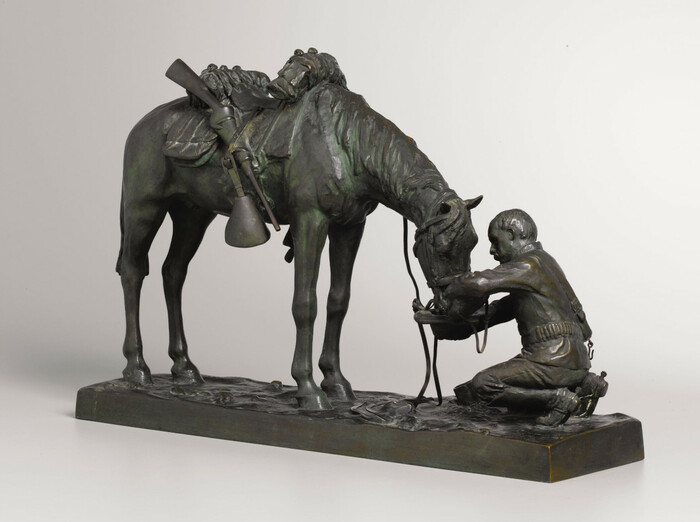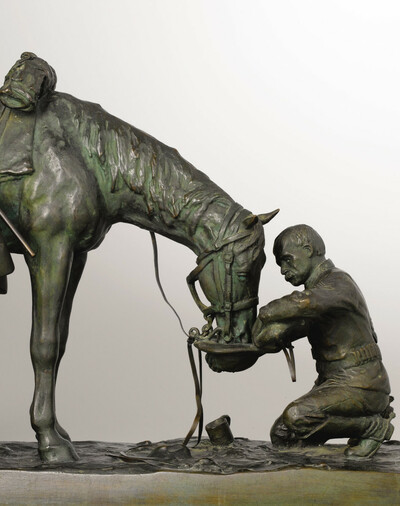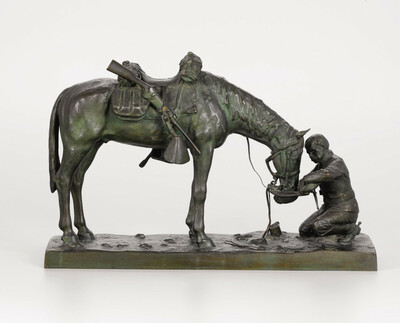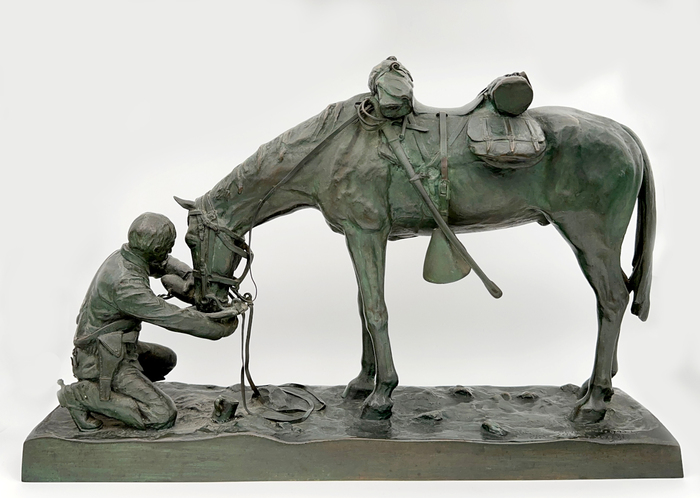Charles Schreyvogel "The Last Drop"
-
- Charles Schreyvogel
- (1861-1912)
- New York / New Jersey Artist
- Image Size: 12" x 18.50" x 5"
- Medium: Bronze Sculpture
- 1903
- "The Last Drop"
- Contact for Price & Info
- View All By This Artist
Details
Western, Cowboy, Horse,
-
-
Biography
Charles Schreyvogel (1861-1912)
One of the better-known painters of Western subject matter, Charles Schreyvogel was especially interested in military life in the days of the disappearing frontier. His western scenes were usually subjects with landscape as the backdrop, and his depictions of Indians were that of people with dignity and pride. "His favorite theme was warfare between intruding whites and Indians defending their ancestral homelands." (Baigell, 321)
He spent most of his life as an impoverished artist and then earned what seemed like overnight fame. "When Remington died in 1909, Schreyvogel wore the mantle of premier Western artist for the brief remainder of his life." (Zellman, 557)
Schreyvogel was born in New York City and grew up in a poor family of German immigrant shopkeepers on the Lower East Side and also spent much of his childhood in Hoboken, New Jersey. He found work in art-related trades including as a Meerschaum pipe carver, goldsmith, and lithographer.
He taught himself to draw, but he studied with H. August Schwabe at the Newark Art League. By 1880, he was teaching drawing and painting and used the roof of his apartment in Hoboken as his studio. In 1887, with the help of several patrons, especially Dr. William Redwood Fisher, he went to Munich, Germany for three years and studied with Carl Von Marr and Frank Kirchbach. Dr. Fisher encouraged the artist to take an interest in western subject matter.
Returning to the United States, he had bad health and was advised to go West to regain strength, but he didn't have the money for several years so he satisfied his aroused interest by sketching cowboys and Indians he saw in Buffalo Bill's Wild West Show.
In 1893, Schreyvogel first went West, visiting Arizona and the Ute Reservation in southwest Colorado. He quickly regained his health and excelled as a horseman. He also learned sign language to communicate with the Indians to persuade them to pose for him. But the resulting paintings didn't sell in the East, so he, having married Louise Walther, earned money with portrait painting of miniatures on ivory while continuing to do western painting.
In the 1890s and 1900s, he made additional trips West, including the Blackfeet Reservation in Montana. In 1901, his work, My Bunkie, won the first-place honor, the Thomas B. Clarke Prize, at the National Academy of Design, and a market for his western paintings and sculpture was set. My Bunkie was a rejected painting that even his local cafe owner had refused to hang, and despairing, he had left it at the Academy. He was so sure he would get no recognition that he had not even bothered to leave his address.
He worked from studios in Hoboken, New Jersey, and from a farm in West Kill, New York, and his Academy success was followed by winning a bronze medal in Paris and another at the Pan-American Exposition in Buffalo.
The money he earned from this recognition allowed him to do more traveling in the West where he gathered material for his studio painting, many of them military scenes. Most of his canvases were large, but he was such a meticulous painter that he only completed about seventy-five western paintings. He also did some watercolors, and many of his paintings were reproduced during his lifetime.
He died in Hoboken from blood poisoning from a chicken bone lodged in his gum. His studio and collection are on permanent display at the Cowboy Hall of Fame in Oklahoma City.
Sources:
Peter Hastings Falk, Editor, Who Was Who in American Art
Matthew Baigell, Dictionary of American Artists
Michael David Zellman, 300 Years of American ArtCHARLES SCHREYVOGEL (1861-1912)
Literature:
J.D. Horan, The Life and Art of Charles Schreyvogel, New York, 1969, page 55.
Charles Schreyvogel was born in New York City in 1861 the son of migrant Germans bound and determined to make America their new home following departure from a tumultuous Europe and, specifically, Germany. His father, Paul, and mother Teresa Erbe Schreyvogel were shopkeepers in New York's lower east side. Charles was the second of three sons born in the family and from his early years in the public schools he surprised his teachers with delightful sketches.
These were the predecessors to his fervent desire to become an artist, an avocation that his prosperous, merchant father found little favor with. He was not to denied and early exposure to August Schwabe, a dedicated fan of the arts and struggling artists, and later to Dr. William Redwood Fisher, led to study in Europe at the Munich Art Academy with Karl von Marr and Frank Kirchback.
Charles Schreyvogel eventually became one of the most popular artists ever to depict the American West in paint and bronze. His early life of struggle with poverty and health led to an ever-present desire to excel. His first national recognition came from a first prize in the 1900 National Academy Exhibition with his entry, My Bunkie. Numerous works were reproduced as lithographs, gravures and platinum prints. The Duel is one such work to have been reproduced.
His extensive forays to the west resulted in field sketches that were used in his Hoboken, New Jersey studio to depict some of the most popular renditions of American cavalry officers and their Indian adversaries. His highly publicized debate with the very popular, and jealous, artist, Frederic Remington, over the authenticity of the ingredients and the scene depicted in his painting, Custer's Demand resulted in an outpouring of support from relatives and friends of Custer: his widow, Elizabeth, President Theodore Roosevelt and Col. J. S. Crosby, himself depicted in the work. His place in history was firmly established by his expertise and talent.
His works are scarce and sought after. Fewer than one hundred paintings are known to have been recorded due to his limited output and short life span. His works are held sparingly by major museums and collections worldwide.Charles Schreyvogel was born in New York City in 1861 and died in Hoboken, New Jersey in 1912. A poor boy on the east side of New York City, Schreyvogel sold newspapers and worked as an office boy while being educated in the public schools. When his parents moved to Hoboken, he carved Meerschaum and was apprenticed to a gold engraver, then became a die sinker, and finally, in 1877, a lithographer.
By 1880, he was a lithographic artist and teaching drawing. By 1887, he had patrons enabling him to study in Munich for three years, the pupil of Carl Marr and Frank Kirchbach. When he returned, he existed as a lithographic artist while unsuccessful with portraits, landscapes, and miniatures on ivory. After sketching the Buffalo Bill Show personnel in New York, he was able to spend 1893 in the West.
For five months, he sketched in Colorado at the Ute Reservation, then went to Arizona to sketch the cowboys. When he came back to Hoboken with a collection of gear, he continued as a lithographic artist while his paintings of Western Army life did not sell. One of these paintings was My Bunkie, which he could not dispose of either as a painting or for lithography in 1899. Offered to a restaurant on consignment, it was hung in a dark corner, so Schreyvogel took it back and entered it in the 1900 National Academy exhibition without leaving his address. When My Bunkie won the highest prize of $300.00, no one at the Academy had until then heard of Schreyvogel or knew where he lived.
Immediately successful, Schreyvogel went West again in 1900, sketching troopers and Indians in the Dakotas for the series of paintings on the Western Army. In 1903, Remington who was the most important Western illustrator called Schreyvogel's work "half-baked stuff", but the soldiers depicted spoke up for him. His output was limited to relatively few major works per year because of the number of his research trips and the size of the paintings, but reproductions were widely published. One set of these was in the form of "platinum prints," that is, large photographs.
When he died in 1912 from blood poisoning after a chicken bone stuck in his gum, he left relatively few Western oils. There were also left clay models that were later cast into bronze.Charles Schreyvogel was Frederic Remington's chief rival during the early years of this century, when interest in artistic depiction of the West was very high. Unlike Remington, Schreyvogel never worked as an illustrator, seeking instead to establish his reputation as an academic artist.
He was born in New York City and in 1886 went to Germany to study at the Munich Academy. Returning to America, he set up a studio in Hoboken, New Jersey, which was then a rural town surrounded by fields and marshlands. Almost immediately he became friends with Nate Salisbury, Buffalo Bill Cody's energetic manager for the Wild West Show, and Schreyvogel spent many hours sketching the Indians and cowboys whom he saw there.
In 1893 Schreyvogel journeyed to the Ute reservation at Ignacio, in the southwestern corner of Colorado. There he observed the Apache, Navajo, Utes, and other tribes who came to receive their government allotments, and he listened to their stories of the Plains Indian wars. He collected great quantities of artifacts, including full costumes and uniforms, which he later utilized in paintings. Returning to Hoboken, Schreyvogel decorated his studio with memorabilia and photographs, and set to work methodically depicting the events of the Indian wars at the close of the frontier period.
The artist researched his subjects painstakingly through various methods of clay modeling and employing live models, prior to transferring their likenesses onto canvas. This enabled Schreyvogel's details to be carefully delineated and subordinated to the whole, which lent itself to telling the story in a complete and cohesive manner. "He is more than a historian of the Indian," one writer observed during the artist's lifetime. "He is giving us an invaluable record of those perilous days of the western frontier when a handful of brave men blazed the path for civilization and extended the boundaries of empire for a growing nation." These words were written after the death of Remington in 1909, when Schreyvogel was proclaimed "the greatest living interpreter of the Old West."
ReSources include: The American West: Legendary Artists of the Frontier, Dr. Rick Stewart, Hawthorne Publishing Company, 1986
Charles Schreyvogel worked as an apprentice to a gold engraver as a young boy and later became a die sinker. In 1877 he tried to earn income as a lithographer, but his lifestyle remained quite meager. He attended the Newark Art League and studied with August Schwabe and then went to the Royal Academy in Munich from 1887-90. He enjoyed painting Western scenes and was able to travel West due to the patronage of W.R. Fischer. While on his trip, Schreyvogel sketched in Colorado and Arizona. He made a second trip west in the same year to sketch troopers and Indians in the Dakotas for a series on the Western Army.
His work did not sell until he entered a painting from his travels, "My Bunkie", into the National Academy of Design exhibition in 1900. He won first prize and gained sudden success at the age of 40. "My Bunkie" is a dramatic Western scene of a cavalryman rescuing an unhorsed comrade from pursuing Indians. Schreyvogel was favorably compared with Frederic Remington, another Western genre painter. "Custer's Demand" (1903) received critical acclaim for its composition, drama and sense of color. Numerous works were reproduced and garnered a large following.
Schreyvogel died in 1912 of blood poisoning and left fewer that 100 known paintings.



